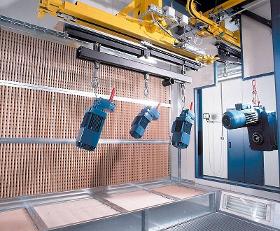- europages
- >
- COMPANIES - SUPPLIERS - SERVICE PROVIDERS
- >
- release agent
Results for
Release agent - Import export

ALWA TECHNISCHE PRODUKTE FÜR KUNSTSTOFFVERARBEITUNG, MODELL UND FORMBAU GMBH
Germany
Release agent H1 (art. no. 9519000) is used to release patterns and moulds. Release agent H1 is applied in a thin coat with a brush or a soft sponge. After the solvent has evaporated, a release film is formed.
Request for a quote
ALWA TECHNISCHE PRODUKTE FÜR KUNSTSTOFFVERARBEITUNG, MODELL UND FORMBAU GMBH
Germany
ALWA release wax (art. no. 9516000) is used to release patterns and moulds. ALWA release wax is applied in a thin coat with a brush or a soft sponge. After the solvent has evaporated, a polishable release film is formed.
Request for a quote
ALWA TECHNISCHE PRODUKTE FÜR KUNSTSTOFFVERARBEITUNG, MODELL UND FORMBAU GMBH
Germany
ALWA release spray (art. no. 9515000) is used to release patterns and moulds. After the solvent has evaporated, a strong release film is formed. ALWA release spray may not be polished.
Request for a quote
ALWA TECHNISCHE PRODUKTE FÜR KUNSTSTOFFVERARBEITUNG, MODELL UND FORMBAU GMBH
Germany
ALWA release lacquer (art. no. 9510000) is used to release patterns and moulds. ALWA release lacquer is applied in a thin coat with a brush or a sponge. A thin coat of ALWA release lacquer can also be sprayed on with a conventional spray gun. We recommend to spray on approx. 2 to 3 layers. After approx. 20 min. a strong release film is formed. The drying process can be accelerated by hot air.
Request for a quote
ALWA TECHNISCHE PRODUKTE FÜR KUNSTSTOFFVERARBEITUNG, MODELL UND FORMBAU GMBH
Germany
Master patterns must be treated with ALWA surface tension remover (art. no. 9500000), so that the ALWA release lacquer does not roll off. ALWA surface tension remover is applied in a thin coat with a brush or a sponge. After approx. 10 min. the solvent is evaporated and ALWA release lacquer can be applied.
Request for a quoteDo you sell or make similar products?
Sign up to europages and have your products listed

RIPPERT ANLAGENTECHNIK GMBH & CO. KG
Germany
Spray walls and spray booths with dry separation via pre-filters and fine filters. Spray walls and spray booths with dry separation For lower utilisation times or overspray quantities, spraying systems with dry separation offer a meaningful alternative to water-sprinkled systems. The Rippert modular spraying system type RTS enables individual adaptation to the respective case of need. Function The overspray is caught by the exhaust air stream and fed to the filter. The solids are filtered out here, while the cleaned exhaust air is blown out into the open air by the fan. Versions The entire spray wall and the drip tray are made of galvanised sheet steel. The basic version consists of a wall with a two-fold filter stage. The attached radial fan is equipped with spark protection in the suction nozzle as well as an explosion-proof motor. The first filter stage is formed by a paper filter or a baffle plate filter, consisting of two rows of galvanised sheet metal lamellae arranged one behind the other. A glass fibre fine filter arranged directly behind it represents the second filter stage. The spray wall can additionally be equipped with removable or fixed side and ceiling panels. Each version is also available with floor suction pan, available with an integrated 2-stage filter and grating cover. Accessories In addition, the spray wall can be equipped with various accessories from the Rippert product range, such as explosion-proof lights, energy-saving flaps, turntables, etc. We recommend the installation of a supply air system for the replacement of the exhausted air. Cleaning / maintenance The spray wall is designed such that the filter elements can be exchanged with little effort in a very short time. For faster cleaning, baffle plate filters should by sprayed with a release agent (e.g. strippable varnish) before being put into operation. Underfloor paint mist extraction With dry separation, consisting of a support structure with attached paper filter, grating cover and a suction duct with air quantity adjustment.
Request for a quoteSIEMPELKAMP MASCHINENFABRIK GMBH
Germany
When resins containing isocyanate (MDI, PMDI) are used, particles and bres are prone to stick and cake to the steel belts in MDF, OSB and particleboard production. These processes require the use of release agents to be sprayed onto the steel belts. In the press infeed drum seat of the ContiRoll® one unit each is installed at the upper and the lower infeed drums. The release agent application device uses a dip roller to spread the release agent onto the press belts. The surface-textured dip roller rotates inside the release agent tub. The dip roller is pressed against the application roller (setting force is adjustable) to transfer the release agent. The applicator roll applies the agent to the steel belt. Features Precise and economical setting of the agent between 7 and 18 g/m²depending on the product.
Request for a quote
SIEMPELKAMP MASCHINENFABRIK GMBH
Germany
The large storage tank facility provides the opportunity to stock sucient quantities of glue, emulsion, liquid hardener, release agents, etc. This ensures that production runs smoothly Features, function Both the tank volume and the tank design are variable, which means that they may be perfectly adapted to the available space of the site. with devices to prevent overlling. Levels are monitored by pressure or radar sensors visualisation. This enables operators to respond to low quantities in time. between tanks allow maintenance to be carried out on individual components without it being necessory to stop production The downstream transfer systems, which include pumps, lters, sensors and fittings have been adaptod to the medium and are always completely pre assembled
Request for a quoteResults for
Release agent - Import exportNumber of results
9 ProductsCompany type